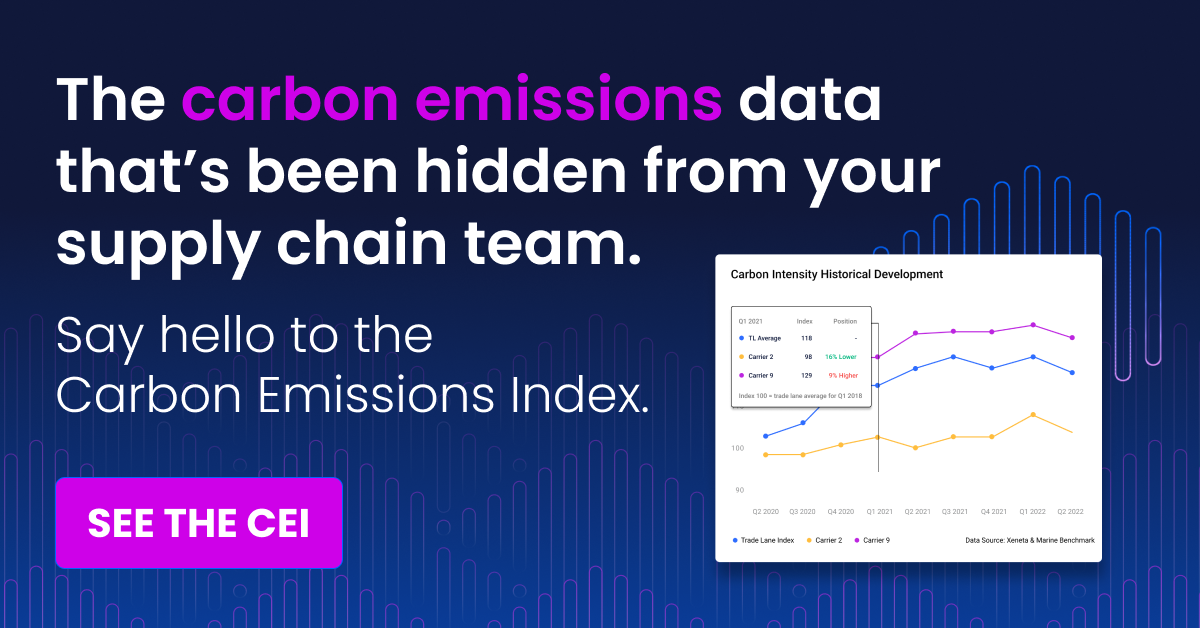We're back with the latest Xeneta and Marine Benchmark Carbon Emission Index (CEI) edition. In this analysis, we're examining the trade route between the Mediterranean and the US East Coast. For Q2, Hamburg Süd topped the list of carriers with a rating of 96.7 points, surpassing the average for this trade lane by 11.0%.
In Q2 2023, the trade lane average from the Mediterranean to the US East Coast decreased from its Q1 value, settling at 108.7 points. Despite this dip, it remains one of only three trade routes among Xeneta's top 13 trades to release more CO2 per tonne of transported cargo compared to Q1 2018. It's worth noting that it has stayed below this level in numerous quarters that have occurred since then.
Q2'23 CEI Carrier Ranking
Mediterranean - US East Coast
|
RANKING |
CARRIER |
CEI SCORE |
| 1 | Hamburg Süd | 96.7 |
| 2 | Hapag Lloyd | 100.6 |
| 3 | CMA CGM | 103.6 |
| 11 | COSCO | 156.4 |
In Q2 2023, Hamburg Süd emerged as the most efficient carrier and was the sole carrier to register a CEI under 100. This suggests its emissions were lower than the average for this trade route back in Q1 2018. The carrier's sequential quarterly enhancement is mainly credited to a 10 percentage point growth in its filling factor, even as the average size of its ships witnessed a minor increment.
.png?width=1195&height=715&name=image%20(1).png)
On the opposite end of the spectrum, COSCO significantly underperformed on this trade route in Q2 2023. Among the major carriers, it utilized the smallest vessels with an average capacity of just under 4,500 TEU, in contrast to the trade lane's average of 6,300 TEU. Even with these smaller vessels, COSCO's filling factor was only marginally higher by 1 percentage point compared to the trade lane's average. A particularly detrimental factor affecting its CO2 emissions was its average speed of 17.2 knots—surpassing other carriers by over 1.8 knots and being 17.0% faster than the trade lane's average speed of 14.7 knots.
The CEI scores for this trade lane haven't been impressive for various reasons. Firstly, the ships deployed here are smaller than on other major trades lanes. Despite this, carriers have struggled to achieve filling factors above 80% over the past year. In Q2 the average filling factor fell to under 74%, the lowest recorded since the start of the CEI in Q1 2018 and 15.3 percentage points lower than Q2 2022. Carriers have also added plenty of capacity to the trans-Atlantic, despite demand not requiring it. Capacity deployed between the Mediterranean and the US East Coast was 30.1% higher this year than in Q2 2022. This has continued with a year-on-year comparison between capacity in August showing a 32.6% increase.
These findings underscore the critical role of capacity management in influencing both freight rates and CO2 emissions. Up until now, carriers have been reallocating tonnage in response to subdued global demand, instead of opting to idle surplus ships. This reduced utilization, which leads to the addition of unnecessary tonnage to certain trades, affects not just freight rates, but also exacerbates the overall carbon emissions from container shipping and the average CO2 emissions per tonne of cargo transported. It is worth noting that in years with high demand, the overall emissions may rise, even while the average CO2 emissions per tonne of cargo transported experience a decline.
Get an honest view of carrier emissions
Stay one step ahead of your competitors by making well-informed and sustainable choices when selecting shipping carriers. Xeneta and Marine Benchmark offer an independent and trustworthy Carbon Emissions Index (CEI) data, ensuring accuracy without any guesswork. By utilizing AIS tracking of real-time sailings on 48 major trade routes worldwide, with coverage expanding further in the near future, you can rely on up-to-date information. Don't settle for outdated and unreliable data. Schedule a demo of the CEI today and begin making intelligent shipping decisions.
%201.png)




